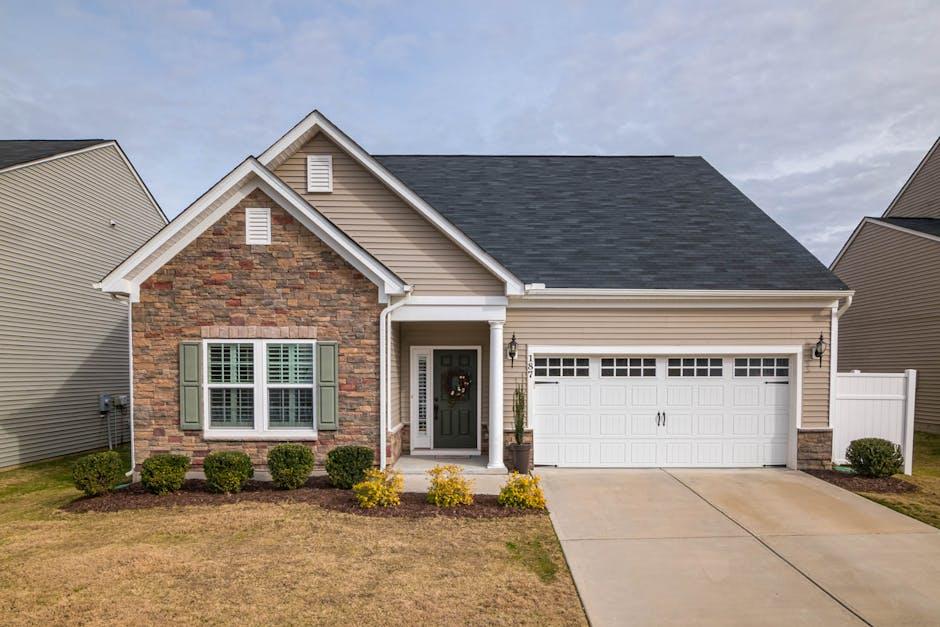As the summer of 2025 unfolds with unprecedented heatwaves across Minnesota, homeowners are facing new challenges that extend beyond the sweltering temperatures. Among these, an often-overlooked victim of the soaring mercury is the humble garage door. While typically regarded as a sturdy barrier against the elements, intense summer heat can subtly but significantly affect the performance, durability, and appearance of garage doors. In this article, we delve into how Minnesota’s rising temperatures are impacting garage doors, exploring the science behind heat damage, common issues encountered, and practical steps homeowners can take to protect their investment during the hottest months ahead.
Table of Contents
- Summer Heat and Its Impact on Garage Door Materials in Minnesota
- Understanding Thermal Expansion and Garage Door Functionality
- Preventive Maintenance Tips for Garage Doors During Extreme Heat
- Choosing Heat-Resistant Garage Doors for Minnesota Summers
- Professional Care Strategies to Avoid Heat-Related Garage Door Damage
- Q&A
- Wrapping Up

Summer Heat and Its Impact on Garage Door Materials in Minnesota
As temperatures soar in Minnesota during the summer of 2025, garage doors face unique challenges due to the intense and prolonged heat exposure. Materials like wood, aluminum, and steel react differently under these conditions. For instance, wood panels tend to expand and warp, causing alignment issues and jeopardizing door functionality. Aluminum, while lightweight, can become distorted in the heat, leading to dents and a compromised seal. Steel doors, though generally sturdier, absorb heat and can transfer it inside the garage, raising indoor temperatures significantly. Understanding these material responses is crucial for homeowners aiming to prolong the life of their garage doors amid the record-breaking summer warmth.
To better illustrate how various garage door materials are affected, consider the following summary:
| Material | Heat Reaction | Common Issues | Maintenance Tip |
|---|---|---|---|
| Wood | Expands and warps | Misalignment, cracking | Seal regularly, repaint annually |
| Aluminum | Dents and bends easily | Compromised frame, poor insulation | Inspect for dents, install UV protection |
| Steel | Absorbs and radiates heat | High interior temperature, rust potential | Use reflective paint, apply anti-rust coating |
Proactive care, such as applying heat-resistant finishes and scheduling routine inspections, can mitigate many of these summer-related issues. Investing time in maintenance not only preserves aesthetics but also enhances the operational integrity of garage doors during the hottest months.

Understanding Thermal Expansion and Garage Door Functionality
The intense summer heat of 2025 brings a significant factor into play for Minnesota garage doors: thermal expansion. As temperatures soar, the metal components of garage doors-primarily steel and aluminum-absorb heat and expand. This seemingly small physical change can cause the door panels to warp or fit more snugly within their frames. Over time, this can lead to challenges in opening or closing the garage door smoothly. Additionally, the rubber seals and vinyl parts may soften or become more pliable, affecting the door’s insulation and security features.
Understanding these effects is crucial for proper garage door maintenance during the hot months. Homeowners should keep an eye out for symptoms such as:
- Difficulty operating the door: Sticking or unusual resistance when lifting or lowering the door.
- Visible warping: Doors that no longer sit flush with the frame.
- Increased noise: Creaking or popping sounds linked to material stress.
By addressing these signs early, you can prevent damage to the springs, tracks, or opener system caused by the door’s altered dimensions. Below is a simple reference table showing typical expansion values for common garage door materials exposed to heat.
| Material | Expansion per 10°F (mm/m) | Common Issue |
|---|---|---|
| Steel | 0.12 | Panel sticking |
| Aluminum | 0.22 | Frame distortion |
| Vinyl | 0.15 | Seal softening |

Preventive Maintenance Tips for Garage Doors During Extreme Heat
Extreme heat can put a significant strain on the components of your garage door system. To keep it operating smoothly throughout the sweltering Minnesota summer, regularly lubricate moving parts such as rollers, hinges, and springs with a high-quality silicone-based lubricant. This helps prevent metal fatigue caused by expansion and contraction under intense heat. Additionally, inspect the weatherstripping at the base of your door for cracks or gaps, as heat can cause rubber materials to dry out and lose flexibility, compromising your garage’s insulation and allowing hot air inside.
Pay close attention to the door’s alignment and balance, as prolonged exposure to heat can cause warping in wooden doors or thermal expansion in metal ones, leading to operational issues. Here are some simple steps to maintain your garage door’s health amid soaring temperatures:
- Check for warps or dents: Heat can distort door panels.
- Test door balance: Manually lift halfway to see if it stays in place.
- Clean the door surface: Reduce heat absorption by removing dirt and debris.
- Ensure proper ventilation: Prevent overheating of the garage interior.
| Maintenance Task | Frequency | Effect on Door |
|---|---|---|
| Lubrication | Every 4 weeks | Reduces friction & prevents wear |
| Weatherstripping Inspection | Monthly | Maintains insulation & prevents air leaks |
| Balance Test | Every 6 weeks | Ensures smooth and safe operation |
| Surface Cleaning | Bi-weekly | Minimizes heat absorption |

Choosing Heat-Resistant Garage Doors for Minnesota Summers
When selecting garage doors for Minnesota’s sweltering summers, it’s essential to prioritize materials that can withstand intense heat without warping or fading. Aluminum and steel doors with a thermal break layer provide excellent insulation against the rising temperatures, helping maintain a lower internal garage temperature. Additionally, doors with reflective coatings or light colors can deflect heat rather than absorb it, reducing the stress on the door material and extending its lifespan.
Beyond materials, the structural design of the door also plays a crucial role in heat resistance. Look for features such as:
- Insulated cores: Polyurethane or polystyrene foam cores offer superior thermal protection.
- Ventilation options: Proper ventilation helps dissipate heat buildup inside the garage.
- UV inhibitors: Protective finishes that prevent sun damage and color fading over time.
| Material | Heat Resistance | Maintenance | Cost |
|---|---|---|---|
| Steel with Thermal Break | High | Moderate | $$ |
| Aluminum with Reflective Coating | Moderate | Low | $$$ |
| Fiberglass | Moderate | Low | $$ |

Professional Care Strategies to Avoid Heat-Related Garage Door Damage
To sustain the integrity of garage doors under the relentless 2025 Minnesota summer heat, adopting professional care techniques is paramount. Regular lubrication with high-quality silicone-based products ensures that hinges and rollers operate smoothly despite thermal expansion. Additionally, scheduling routine inspections by certified technicians can catch early signs of wear such as warped panels or stretched springs caused by prolonged heat exposure. Implementing these preventive steps minimizes sudden breakdowns that often arise when extreme temperatures push garage door components beyond their limits.
Optimizing the garage environment itself also plays a vital role in protecting your doors. Professional contractors often recommend installing reflective insulation panels inside the garage to reduce direct heat on the door’s interior surface. When paired with a well-maintained ventilation system, this strategy keeps temperatures stable and limits moisture buildup, which can accelerate metal corrosion and wood deterioration. Below is a quick reference table outlining the most effective care tactics:
| Care Strategy | Benefit | Recommended Frequency |
|---|---|---|
| Lubrication of Moving Parts | Reduces friction & wear | Every 3 months |
| Professional Inspection | Identifies early damage signs | Biannually |
| Installation of Reflective Insulation | Limits heat absorption | Once/installation |
| Ventilation Maintenance | Prevents heat/moisture build-up | Monthly checks |
Q&A
Q: How will the 2025 summer heat impact garage doors in Minnesota?
A: The unusually high temperatures forecasted for Minnesota’s summer of 2025 can cause significant stress on garage doors. Heat expands metals and can warp wooden components, leading to alignment issues, sticking, or cracking. The increased UV exposure might also degrade paint and weather seals faster than usual.
Q: Which garage door materials are most vulnerable to the intense summer heat?
A: Wooden garage doors are particularly susceptible to warping, cracking, and fading under prolonged heat and sun exposure. Metal doors, while more heat-resistant, can expand and misalign if not properly maintained. Vinyl and composite doors tend to handle heat better but still require regular upkeep to avoid damage.
Q: What signs should Minnesota homeowners watch for that indicate heat-related garage door problems?
A: Look for doors that stick, creak, or fail to close fully, hinges or springs that appear stretched or bent, paint that is blistering or peeling, and seals that have cracked or warped. These signs suggest the garage door components are struggling under the heat’s effect.
Q: Can the summer heat affect the garage door opener or its electronics?
A: Yes, the heat can cause sensitive electronic components in garage door openers to overheat, leading to malfunction or reduced lifespan. Ensuring proper ventilation and periodically checking the opener for signs of heat damage can help maintain its functionality.
Q: What maintenance steps can mitigate heat damage to garage doors in 2025?
A: Regular inspections and timely repairs are key. Applying heat-resistant paint or finishes, lubricating moving parts, ensuring weather seals are intact, and scheduling professional tune-ups before and after the hottest months can greatly reduce heat-related wear and tear.
Q: Are there any design considerations homeowners should keep in mind for heat resilience?
A: Choosing lighter-colored doors with UV-resistant coatings can reflect more sunlight and reduce heat absorption. Additionally, investing in insulated garage doors helps prevent extreme temperature fluctuations inside the garage, protecting both the door and stored items.
Q: Will insurance cover heat-related garage door damages?
A: Coverage varies by policy and provider. Some homeowner insurance plans may cover damage from severe weather or heat-related wear, but many consider gradual deterioration as maintenance issues, which are typically not covered. It’s advisable for homeowners to review their policies and consider additional coverage if needed.
Q: How long can garage doors typically withstand the summer heat without serious issues?
A: With proper maintenance, most garage doors can endure Minnesota’s summer heat without major problems. However, the extreme conditions predicted for 2025 may accelerate aging, making proactive care even more crucial to extend the door’s lifespan and functionality.
Q: What are the consequences of ignoring heat effects on garage doors?
A: Neglecting heat-induced damage can lead to costly repairs or complete door replacement. It can also pose safety risks if the door malfunctions or breaks unexpectedly, as well as inconvenience in daily use.
Q: Where can Minnesota homeowners find expert help for garage door issues related to the summer heat?
A: Local garage door service companies often offer specialized seasonal inspections and repairs. Seeking experts familiar with Minnesota’s climate and the 2025 summer conditions ensures tailored advice and effective solutions.
Wrapping Up
As Minnesota’s summers continue to turn up the heat, understanding how soaring temperatures impact your garage doors becomes more than a mere curiosity-it transforms into a necessary part of home maintenance. The 2025 summer promises challenges for homeowners, reminding us that even the most overlooked structures are subject to the whims of weather. By staying informed and proactive, you can ensure your garage doors withstand the heatwave without losing function or charm. After all, in the dance between nature and nurture, a little care goes a long way in keeping the summer’s blaze from turning your garage into an unintended sauna.





